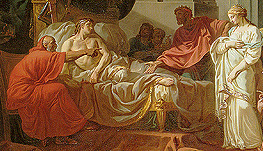

In the fourth century BCE the most important locus of medical thought and practice was not the island home Cos of Hippocrates, but the great center of Greek learning at Alexandria, founded in 331 BCE by Alexander the Great and governed by a dynasty stemming from his general Ptolemy. The Ptolemaic rulers gave lavish financial support to the library and museum at Alexandria which consequently attracted researchers in all fields, including philosophy, mathematics, history, poetry and medicine. Medical research in the Alexandrian museum became world renowned. Two of its most influential investigators were Herophilos of Chalcedon (fl. circa 280 BCE) and Erasistratos of Iulis (fl. 250 BCE). Most of our knowledge of these two is derived from later commentators, such as Celsus and Galen in the Roman period.
| Herophilos’ most important contribution to clinical medicine was his development of the theory of the diagnostic value of the pulse. Although the pulse is referred to occasionally by earlier writers (for example by Aristotle in his Inquiry Concerning Animals 521a5f), it was Herophilos’ teacher, Praxagoras, who first restricted the pulse to a distinct group of vessels and held that it could be used as an indicator of disease. Herophilos corrected his master’s teaching on several points, maintaining that the pulse is not an innate faculty of the arteries, but one they derive from the heart, and distinguishing the pulse not merely quantitatively, but also qualitatively from palpitations, tremors and spasms, which are muscular in origin. |
